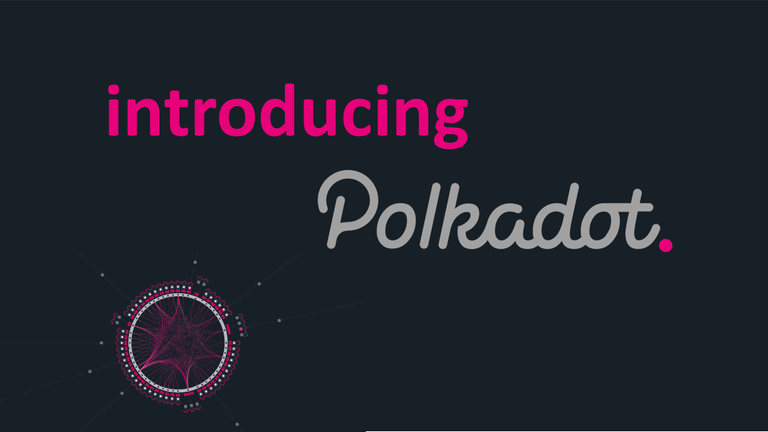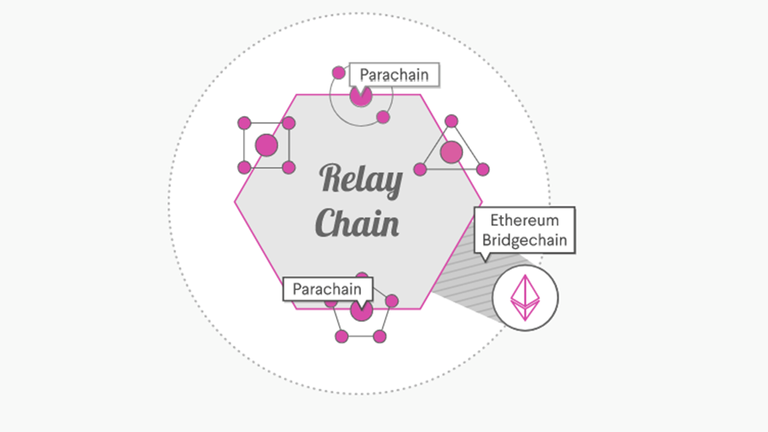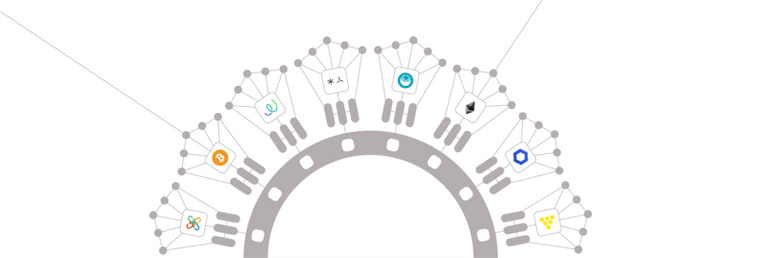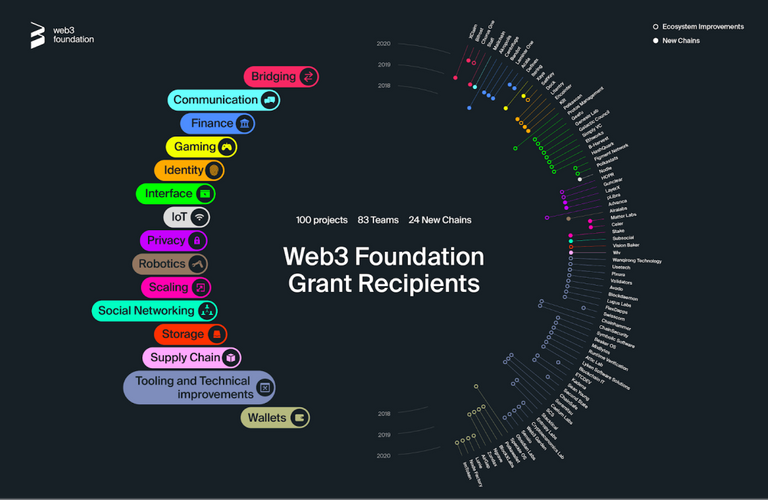Some of you maybe already heard about Polkadot project. It took the crypto space by the wave and due for a reason. Forget about the ICO bubble, forget about the DeFi bubble. This is far beyond these while it can be kind of connected to DeFi of course. Today let me tell you about a project called Polkadot.

What is Polkadot?
Polkadot’s goal is to become the new internet of blockchains that are going to seamlessly communicate with each other. You may ask, why do we need something like that if there are already so many great platforms out there, like an Ethereum, Cardano, or EOS. Well, creators of Polkadot believe that no single blockchain can serve all purposes efficiently in a fast and secure way. Imagine future Ethereum 2.0 with improved transaction speed hosting billions of smart contracts serving all the different applications — this is not simply going to be effective and it will definitely not scale well. Therefore, welcome to the world of the Polkadot network, a project which tries to bring all the different blockchains under one roof and provide the best platform for any project which you can think of.
How Polkadot works
Polkadot is a new generation blockchain protocol that greatly simplifies cross-chain communication and interoperability by bringing multiple blockchains into one network. This network is going to be secured by a GRANDPA consensus algorithm, tailored for the Polkadot (a flavor of a PoS, detailed information are on Polkadot’s wiki).
The most critical parts of the Polkadot network are Relay Chain, Parachains, Parathreads, and Bridges. We will talk more about each of these in the following section.
Relay Chain
Relay chain is the backbone of Polkadot’s network and it’s the main communication hub between parachains. Validators on this chain are accepting blocks from all parachains and thus providing security for the whole network.

Parachains
Parachains are independent blockchains that will run on top of the Relay Chain a provide chain-specific features to the Polkadot network. Each parachain will serve a specialized purpose in the network — think of having a fine-tuned chain for smart contracts, another chain that will provide a stable coin for payments between chains or a parachain which will bring a decentralized energy industry to the network.
Each parachain will be maintained by the collator which is responsible for producing chain blocks. Parachains will also benefit from a shared security model provided by the Relay Chain so there are already secured against 51% attacks or similar.
However, there will be only a limited amount of parachains in the network (and the number will be increasing in the future) so there is a system of public auctions where parachains candidates will have to compete in order to obtain their own slot.

Parachains
Parathreads
Parathreads are very similar to parachains from a technical point of view, however, they are very different from an economical standpoint. As we said in the previous paragraph, parachains have to compete in auctions in order to become part of the network. On the other hand, the parathread slot can be leased almost instantly and for only a short period of time.
This will provide a different way how to run projects on the Polkadot — some of those projects can benefit from trying out the network before purchasing an expansive parachain slot, others can run as a parathreads before they win an auction for a slot.
Bridges
Can you imagine a modern blockchain platform running in complete isolation from other, already established networks? The Polkadot’s authors definitely couldn’t and that’s why we have a special kind of parachain, called the bridge. Bridges will connect other already running blockchains into the ecosystem (like a BTC or ETH) and allow for transfers of tokens between Polkadot and outside networks.
Thanks to its structure, Polkadot brings many advantages over other blockchains:
Scaling
Do you remember all the discussions in the BTC community which eventually led to the creation of Bitcoin Cash and still “hated by many” Lightning Network? Or fees for transactions in Ethereum getting insanely high? Well, those issues are all coming from scaling problems which 1st and 2nd generation blockchains have.
Some of the scaling problems stem from the fact that every node in the network has to process all the transactions one by one in most of the blockchains. But this is not the case with Polkadot, parachains got their name by the fact that they will run and produce their blocks in parallel and validators will take care of the rest — which greatly amplifies speed of the network.
For those who like to see the numbers — based on the last benchmark, even simple implementation without parachains can reach 1000 tx/s. But we can possibly get as high as to the 1,000,000 tx/s after parachains will be fully functional.
Specialization
If we think about most of the blockchains, they all are trying to support various features and all of them have to make some trade-offs in order to achieve that. But, in the Polkadot, it’s very easy to deploy one parachain which will serve as file storage, another chain that will provide decentralized identity management and another one for enabling payments in the whole ecosystem by creating a stable coin. Imagine how effective, simple, and secure specialized blockchains can be by skipping all the code which is normally necessary to deploy a full-fledged chain.
Also, Polkadot already provides a simple SDK (Software Development Kit) called Substrate which will make creating and deploying parachains easy. No more code writing from scratch!
Cooperation
All parachains and bridges can share information like applications on the smartphone share underlying features of the phone’s operating system. One of the biggest benefits of Polkadot is that parachains are not going to run in isolation but they will be able to communicate with each other. And not by just simple token transfers but they can actually exchange any kind of messages. For example, a chain providing synthetic asset trading (let’s stay stocks or commodities) can go to the oracle running in a different parachain and ask for a stock price.
Cross-Chain Messaging Protocol (XCMP) allows parachains to send messages of any kind. The shared security model together with XCMP finally provides a trustless environment for a verifiable message transfer which opens the door to the real interoperability.
Governance
The Polkadot community can govern the network in a completely decentralized way. An example of how such a voting process can be found in our article How Polkadot token denomination can affect trading.
The process of enabling complete governance is still undergoing, however, Polkadot in the future will be completely run by the community in a transparent manner. The community can then set rules for parachains actions, number of slots, and basically experiment with any ideas which will come into their mind. Governance itself can eventually be perfected over time which makes Polkadot one of the most flexible networks out there.
No hard forks
Like all the other software, even blockchains needs to be upgraded either for security reasons (bugs can always creep into your code) or when community votes for adding new features. Normally, most of the blockchains require a hardfork, especially when making significant changes to the network (like consensus protocol upgrade). Unfortunately, this process can sometimes give a hard time to the community and even lead to the network split like in the case of Bitcoin Cash.
Polkadot allows parachains and even its own network to update without any hardforks in a completely seamless manner which allows the network to be gradually perfected.
When we connect all the dots (pun intended :)), it gives us a clear picture that Polkadot takes a completely new approach to the decentralized network development. It’s not trying to develop the whole world on top of a single blockchain but rather provide a safe, trusted, easily deployable, and upgradable environment where anyone can deploy its chain and benefit from cooperation with the others.

Ecosystem
The Polkadots ecosystem is growing bigger every day because development teams are realizing the advantages of such a flexible, effective, and secure network. Unification of multiple specialized chains into one highly scalable, interconnected network allows any blockchain to reach its full potential for any real-world scenario in preparation for a new, decentralized economy. The projects don’t have to compete with each other anymore, they can now work together in the Polkadot network so all of us can achieve independence from the centralized world.
Some examples of projects which are already in the development are Kusama, Acala Network, Energy Web Token, ChainX, Robonomics, Sora, etc.
Team
Polkadot was founded by a team around Web3 Foundation which strives for the decentralized web. Polkadot’s leading figure is a Dr. Gavin Wood which some of you may know as one of the founding fathers of Ethereum and author of the Solidity smart contract programming language.
There is also a Robert Habermeier, co-founder of Polkadot, Thiel Fellow, and of the most distinctive members of the Rust programming language community. He has a plethora of experience with research and development of decentralized networks, distributed systems, and cryptography.
Last but not least, Peter Czaban, an Oxford University graduate with plenty of experience from financial and data industries who were mainly working on quantitative price models, machine learning, and other related fields.
Tokens
Polkadot is using it’s DOT tokens for various purposes
Governance — token holders can vote for protocol upgrades and new feature proposals
Staking — you can stake your tokens in favor of the Polkadots security model. Honest validators are being rewarded by the network for their stake
Bonding — parachains are winning their slots by locking up DOT tokens
Fees — for message passing between the parachains
The total supply of DOT will then become 1,000,000,000.
Token price
Polkadot passed through its ICO on the 14th of October in 2017 and the price for 1 DOT was $28,80. It was one of the most successful ICO ever conducted and the project raised $145 million in the first round of sales.
Today's price is around $6 per DOT token. Polkadot (DOT) is in 6th place on the CoinGecko rank.

Conclusion
Interoperability and scaling are the next major steps in the blockchain industry. Bitcoin presented a revolutionary change in a way how people think about currencies and decentralization and Ethereum and other 2.0 blockchains brought smart contracts into the industry.
Polkadot is one of the biggest players which is going to bring blockchain to the 3.0 era — and this will change the blockchain landscape forever. Interoperability is the missing piece that the blockchain industry desperately needs and it will definitely attract many interesting projects and previously unseen use cases of decentralized networks and currencies.
Hey man!
You already know that Project hope does not support Plagiarism.
Can you give me an explanation of this ?:
https://medium.com/@polkadotters/what-is-polkadot-85d4af1b2fe7
More than 70% of your text is identical.
Hi @juanmolina,
this is my content, it is just a misunderstanding. I was not sure if post this link or not (to medium), so maybe it was a mistake not to do so.
Sometimes when I want some content to catch more readers I post it to my web blockchainfo.cz and as well to hive and/or to some more sources. About this medium article, we started "Polkadotters" not long ago and as we think Polkadot is a superb project, we felt like sharing this info about this "no 3 of crypto after Bitcoin and Ethereum" to Hive and Project Hope community as well. We might come back to this article a few years later and we will see if it is such a big thing (I think it will be). Like when someone wrote after launching Ethereum a few years ago that it will be a big thing (to maybe put a few dollars into).
Mostly I post my work at the same time to my web and Hive, so it don't grab the attention of cheetahs etc., but this time I did it with a small delay and probably it was not a good idea.
I just added to the end of the article on medium, which you mentioned, a word about sharing the article on hive.blog as well as proof of ownership of this content. Just check the very end of the article there.
Appreciated @blockchainfo.
I was waiting for this response from you publicly (we had already spoken by DM).
This explanation clears any doubts as to the veracity of your post.
I am sorry for the confusion I have generated, but we must be vigilant for any possibility of plagiarism.
Thanks for being so thoughtful and consistent.
I just gave you 50 Claps.
Thank you, I appreciate it.
PS. I really like what you doing with a checkup of possible plagiarism violation, I think it really adds value to Project Hope in the long run!
This is the way blockchain is going. Well any true project. Sure there are specific needs like legal, insurance, logistics, AI... But, a new internet of blockchains and interoperability rather than BTC vs ETH. Liquid Apps is another prime example of interoperability. Though Liquid could be that key that enables another project like Polkadot to fully realize its potential.
I think there is huge potential in interoperability and its related blockchains - not just Polkadot, but as well Cosmos (ATOM) and Dfinity and a few others. We are in fascinating times. Yes, it's not anymore just about transferring value from Alice to Bob.
Have come accross ATOM, but first I hear of Dfinity. ty
It's a genius !, and it looks like a project that it's going to give a lot to talk about personally I really like the part that there will be specialized chains or focused on specific topics; I really like this I thank you for sharing such valuable information
I like to write about a project which I am interested in, that makes me know even more about them. So I feel good when I can spread this for others as well.